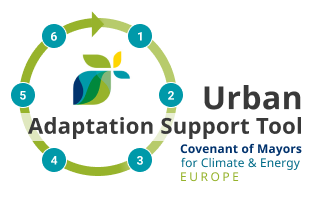
0
Getting started
Principles and success factors
Adaptation to climate change is a relatively new area of activity for local authorities. However, the experiences of cities, both within and outside Europe, over the last two decades allow to draw conclusions about the principles (i.e. how to do things) and success factors (i.e. what works) to consider in adaptation. The principles emerge as aligning adaptation with other sustainability goals, including reduction of greenhouse gases emissions; and basing development of adaptive actions on reliable data and information. The key success factors are strong championship and political leadership for adaptation; working in partnership with others across and beyond the city, also at higher governance levels; and learning from the experiences of others.
Several principles in the adaptation policy process are recognized as helping to achieve adaptation goals and minimise trade-offs with other agendas. These are as follows:
- Sustainability of adaptation. Firstly, adaptation responses should not compromise the mitigation of climate change through increased emissions, e.g. through excessive use of air conditioning (see Step 5.4 for how adaptation and mitigation can be planned and implemented together). Secondly, adaptation efforts in one location should not negatively affect the ability to adapt in other locations (e.g. through directing flood waters downstream); thus considering the role of areas surrounding the city in adaptation is important (see Step 2.5). Thirdly, adaptation should ideally contribute to other sustainability agendas such as transition to resource efficiency or social justice.
- Evidence-based planning and actions – making use of the latest research, locally available data (see Step 1.2) and collaborating with scientists to address the knowledge gaps (see Step 1.6) allows well‐informed decision making.
- Addressing both past/ current climate variability and weather extremes and projected future changes. Addressing past and current climate variability and weather extremes (see Step 2.1) is a good starting point. However, the future climate impacts may be different, and there is uncertainty associated with their frequency and magnitude should be considered (see Step 2.2). No or low regrets and win-win adaptation options in terms of cost-effectiveness (see Step 4.2) and multiple benefits can help take action despite uncertainties related to future climate projections.
- Tailored responses. Adaptation responses should be tailored to the particular location – by assessing the locally occurring and projected climate risks and vulnerabilities (see Step 2), but also considering the particular organizational setup (see Step 1.3) or resources available (see Step 1.4 and Step 1.5). The responses should be prioritized (see Step 4.3), for example depending on the main sectors or social groups affected (see Step 2.3).
- Monitoring of the functioning of adaptation responses - their effectiveness, efficiency, equity and legitimacy – is necessary in order to gradually improve them according to the evolution of evidence (see Step 6).
The examples of success factors in adaptation that emerge include the following:
- Strong leadership and championship of adaptation. Political buy-in and engagement of a local leader are key to increasing the position of adaptation on the list of local priorities. Ensuring political commitment can be for example achieved by joining the Covenant of Mayors for Climate and Energy or other initiatives on climate change adaptation (see Step 1.1)
- Collaboration. Cross-departmental collaboration within the local authority, working together with stakeholders such as local businesses, NGOs, research institutes (see Step 1.6) and engaging citizens through appropriate communication (see Step 1.7) help to raise awareness of adaptation and acceptance of planned responses, secure buy-in among important groups of interest, mobilise resources and access relevant data and information.
- Learning from others. Exchanging experiences with other cities through networking or participation in EU-funded projects (e.g. through the Interreg programme) allows learning from others what works and what does not in adaptation. In addition, the Climate-ADAPT pages include numerous case studies of urban adaptation, as well as the Covenant of Mayors resource library (search by resource type - case study).
